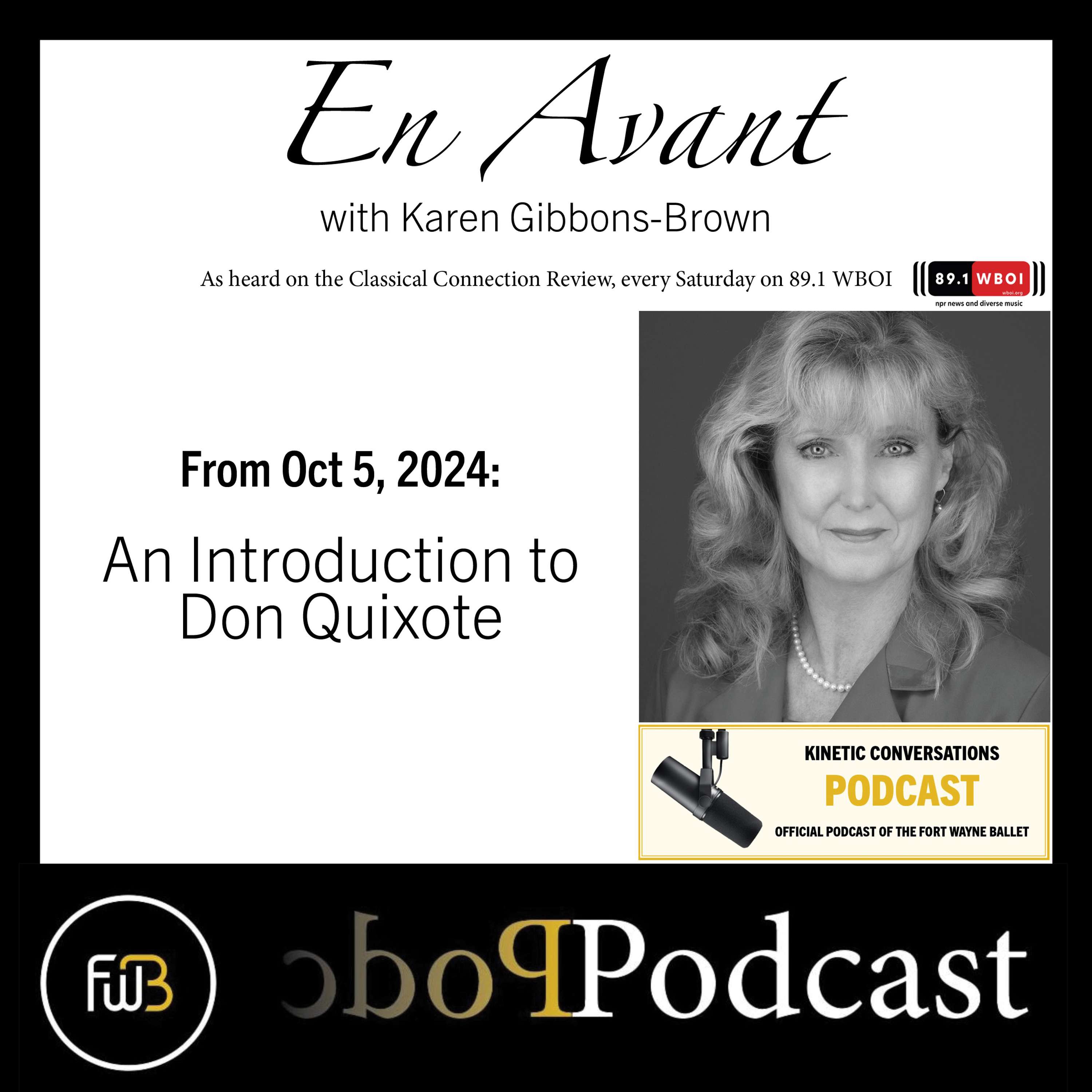En Avant with Karen Gibbons Brown can be heard every Saturday night on the Classical Connection Review on 89.1 WBOI.
Hello and welcome to Univon, a ballet discussion brought to you by Fort Wayne Ballet and the Kinetic Conversations podcast.I'm Fort Wayne Ballet Artistic Director Karen Gibbons-Brown. And I'm so glad you've joined us today.
Our topic for today's discussion is the Ballet Don Quixote.I'm sure many of you are familiar with the traditional literature of Don Quixote by Cervantes.Well, the ballet is based somewhat on that story.
However, there are only a couple of chapters pulled out of the book specific to the ballet that you might see if you went to the theater. That's very traditional for us in dance.
For instance, the Nutcracker is only two or three chapters of the whole book about the Nutcracker and the Mouse King.
This story is about a man who is searching for his ideal, ideal life, ideal woman, ideal future, and he goes through many villages in his search.This particular ballet is placed in a village in Spain, and it is the story of two young lovers
Ketri, who is the daughter of a man who runs the local market, and about a young man named Basil, or Basilio, who is a barber in town.Ketri and Basil would love to be married.However, Ketri's father has better plans for her.
He has his own ideal in that she should marry somebody who has more fortune.The person in the village with all the fortune is a comedic character named Gamache.
Gamache is a very well-refined gentleman who does have all the money, but he's just a little bit kooky.Khitri's father would like her to marry Gamache, but she'd prefer to marry Basilio.
As Don Quixote wanders into this village, he wanders into this melee of the two lovers wanting to be married and the father fighting this to his last breath.It is a comedy.The story has been made into a ballet many times over.
In fact, the first ballet started in the 1740s, the first ballet of Don Quixote.It was created by one of our forefathers of dance, Duvert.
Because it is such a traditional piece of literature, we've always come to that particular story as something of fun and frolic for dancers.
Dancers love the ballet because the music is uplifting, it's a lot of fun, there's a tremendous amount of zest and energy. all the way through the production.
Historically, this ballet started in the 18th century, but it has been revisited many times over by many choreographers.
Marius Petipa created a version that started out as three acts in the 1860s, and he expanded it to be five acts and 11 scenes by the time he had finished his tenure with the Russian Ballet.
Our audiences don't quite withstand that sort of performance any longer, so along comes a gentleman, Gorski, who choreographed it back to three acts and about eight scenes.
The ballet has maintained what we call the grande pas de deux, or dance for two. The Grand Pas de Deux is a showcase piece that you might often see in a gala.It's often a piece you might see performed just to show off two dancers and their skills.
But it actually goes into the full-length ballet, and it is considered the Wedding Pas de Deux of Kitri and Basilio.Yes, they do get married in the end.Spoiler.But what leads to that marriage is the comedy of the ballet.
The ballet that you most commonly see is choreographed or based on the choreography by Gorski.The music is by Minkus.
There are a couple of other orchestral versions of Don Quixote, and there is one that Balanchine choreographed, too, which is not at all the Minkus version.
And he was actually Don Quixote, and he choreographed it on his muse, Suzanne Farrell, to play the part of Dulcinea, or Keetree. So, it has a pretty speckled history, but it's a ballet that you wouldn't want to miss.
Hoping that you have the opportunity to see it, join us next time for our conversation, again, about Don Quixote.
N.I.V.A.N.is brought to you by Kinetic Conversations, the official podcast of Fort Wayne Ballet.Our opening music is the Allegro from Don Quixote by Ludwig Minkus, performed by Nadine Todorov with the Sofia National Opera Orchestra.
Our closing music is by John Dawkins. Fort Wayne Ballet is performing Don Quixote October 18th and 19th at the Pearl Street Arts Center.Tickets are available at fortwayneballet.org and the ArtsTix Community Box Office.
Kinetic Conversations podcast is available on most audio streaming platforms.
 Sign in
Sign in Sign in
Sign in Sign in
Sign in










